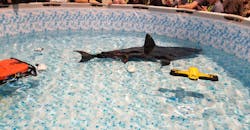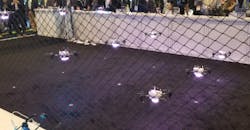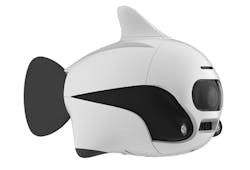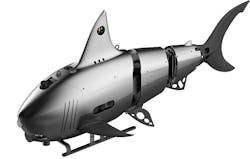The drone section at the Consumer Electronics Show (CES) was dominated by quadrotors and underwater drones. Uvify’s quadrotor demo (Fig. 1) was typical of the synchronized swarms flying within cages to protect attendees and drones alike. Aerial drones have been common at CES for years, but their aquatic brethren have been a rarer sight until this year.
1. Uvify’s quadrotor demo was typical of the synchronized swarms at this year’s Consumer Electronics Show.
Large bodies of water were highlighting these mobile underwater platforms (Fig. 2). The demos included autonomous as well as tethered, remote-controlled drones. Like flying drones, the underwater drones can perform inspection chores in addition to other photographic and exploration jobs.
2. Large pools of water were common in the drone section at CES.
The Navatics Mito (Fig. 3) packs in a 4K camera with 1080p streaming capabilities. It can record 4K video streams that are downloadable on recovery. It has built-in active stabilization common in quadrotors. The swappable battery provides four hours of operation.
3. Navatics’ Mito sports a 4K camera and active stabilization.
The Mito is paired with a waterproof buoy with a wireless connection to a remote-control unit. This can be up to five hundred meters from the buoy.
Robosea’s Biki is a compact, autonomous underwater drone (Fig. 4). The cute drone comes in different colors and they have a gimbal-mounted 4K camera. There’s a pair of 114 lumen lights for operation in the dark. It uses acoustics for remote control. A smartphone app can wirelessly control the unit when it’s is on top of the water. And a return-to-base feature that uses built-in GPS works when the unit is on the surface.
4. Robosea’s Biki is a compact, autonomous underwater drone with a 4K camera.
The Biki uses a caudal fin that can drive it to speeds of 1.12 miles/hr. It uses infrared sensors to avoid obstacles up to 30 cm away. The drone can dive to depths of 196 feet.
Robosea’s larger Robo-shark is almost two meters long (Fig. 5). It’s articulated and driven by a caudal fin like the Biki. It has an omnidirectional obstacle avoidance system and internal space for add-ons, providing a more professional platform than the Biki.
5. Robosea’s large Robo-shark swims like a shark but does not bite.
The Robo-shark can dive to three hundred meters and has a 1.5- to 3-km range. It can travel at speeds up to 10 knots while being significantly quieter than propeller driven drones. The shell is made of sound-absorbing materials.
Chasing Innovation’s Gladius Mini has five thrusters to help provide the 4K camera with a stable platform (Fig. 6). The three vertical thrusters are laid out in a triangle; all five are under control of the AI-based system. The pitch angle can be set plus or minus 45 degrees while moving.
6. Chasing Innovation’s Gladius Mini has a 4K camera and a one-touch depth lock mode.
The Gladius Mini fits into a backpack and has a two-hour runtime. It can dive to depths up to 330 feet, although it comes with a 165-foot tether, and cruises at a fast 2 m/s. A one-touch depth lock mode keeps the unit at a particular depth. This is similar to many quadrotors with hover mode.
Just to highlight how wet CES was this year, I leave you with this shot of Gigabyte’s liquid-cooled server (Fig. 7). This essentially drops the electronics into an aquarium. It makes changing boards a bit more difficult since everything must be removed, but it does work. The two-phase immersive cooling system doesn’t require pumps like those used in conventional, conductive liquid cooling found in many high-end gaming PCs. This isn’t a test. It’s a system that can be purchased, as is the case with the other flying and aquatic drones mentioned here.
7. Gigabyte was showing a liquid-cooled server.
About the Author
William G. Wong
Senior Content Director - Electronic Design and Microwaves & RF
I am Editor of Electronic Design focusing on embedded, software, and systems. As Senior Content Director, I also manage Microwaves & RF and I work with a great team of editors to provide engineers, programmers, developers and technical managers with interesting and useful articles and videos on a regular basis. Check out our free newsletters to see the latest content.
You can send press releases for new products for possible coverage on the website. I am also interested in receiving contributed articles for publishing on our website. Use our template and send to me along with a signed release form.
Check out my blog, AltEmbedded on Electronic Design, as well as his latest articles on this site that are listed below.
You can visit my social media via these links:
- AltEmbedded on Electronic Design
- Bill Wong on Facebook
- @AltEmbedded on Twitter
- Bill Wong on LinkedIn
I earned a Bachelor of Electrical Engineering at the Georgia Institute of Technology and a Masters in Computer Science from Rutgers University. I still do a bit of programming using everything from C and C++ to Rust and Ada/SPARK. I do a bit of PHP programming for Drupal websites. I have posted a few Drupal modules.
I still get a hand on software and electronic hardware. Some of this can be found on our Kit Close-Up video series. You can also see me on many of our TechXchange Talk videos. I am interested in a range of projects from robotics to artificial intelligence.









